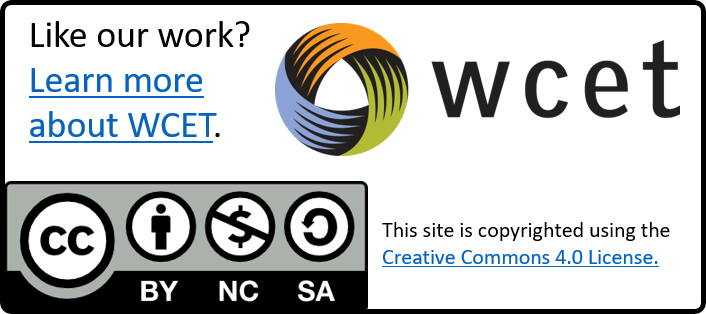Online education can often be polarizing—some advocates champion it as higher education’s savior, bringing access and affordability to students across the globe. Others see it as the modern equivalent of a Trojan horse come to assault the quality of higher education.
Questions of the quality of online education aside, one of the biggest lightening rods around online education is cost. Here we find practitioners explaining that quality online education does not cost less than face-to-face instruction often facing off against legislators with visions of efficiency dancing in their heads.
I recently had the opportunity to attend the Western Interstate Commission for Higher Education (WICHE)’s Legislative Advisory Committee and participate in a panel on crafting sustainable infrastructure in higher education. The panel’s focus was on crafting capital funding models that “take into account not just buildings and maintenance, but also key 21st century considerations such as technology.” I joined the panel to talk about the role and the costs of online education. As a veteran of Texas higher education budget wars who once had the unenviable task of trying to explain online education costs to Texas legislators (and an evaluator on more capital improvement proposals than I want to remember), this experience got me thinking about how we, as practitioners of and advocates for online education, should be talking about its perceived and real costs.
Setting the stage: The twin realities of money and students
 The State Higher Education Finance FY 2018 report by the State Higher Education Executive Officers Association found that “Ten years out from the start of the Great Recession, per-student higher education appropriations in the United States have only halfway recovered.” Furthermore, the study went on to report that only nine states had per student appropriations at a pre-recession funding level. The report went on to note that although there had been increases in funding since the Great Recession, it appeared that appropriations were flattening with only a .2 percent increase between FY 2017 and FY 2018 once adjusted for inflation for an average of $7,853. Public institutions, attempting to find some way to backfill state funding losses, have been forced to rely upon net tuition revenue, which has grown from 35.8 percent of higher education funding in 2008 to 46.6 percent in 2018.
The State Higher Education Finance FY 2018 report by the State Higher Education Executive Officers Association found that “Ten years out from the start of the Great Recession, per-student higher education appropriations in the United States have only halfway recovered.” Furthermore, the study went on to report that only nine states had per student appropriations at a pre-recession funding level. The report went on to note that although there had been increases in funding since the Great Recession, it appeared that appropriations were flattening with only a .2 percent increase between FY 2017 and FY 2018 once adjusted for inflation for an average of $7,853. Public institutions, attempting to find some way to backfill state funding losses, have been forced to rely upon net tuition revenue, which has grown from 35.8 percent of higher education funding in 2008 to 46.6 percent in 2018.
Coupled with these appropriation trends are shifts in enrollment. Institutions of all sizes and types are experiencing decreases in their enrollments. Most recently, the National Student Clearinghouse Research Center found that 2019 marked the eighth consecutive year that student enrollments declined, including a 1.7 percent decline between spring 2018 and spring 2019.
But there is one area of college enrollments that are bucking this trend—online learning. As Inside Higher Ed reported last fall, “Without online education, college and university enrollments would be declining even more.” As of fall 2017, 15.4 percent of all higher education students were exclusively enrolled in online education, roughly 1 in 6 students.  So given flat appropriations, declining overall enrollments, and increasing online enrollments, it’s no wonder that state legislators are less interested in talking about brick and mortar and more interested in how online education can help flagging state dollars go farther.
So given flat appropriations, declining overall enrollments, and increasing online enrollments, it’s no wonder that state legislators are less interested in talking about brick and mortar and more interested in how online education can help flagging state dollars go farther.
Can’t we all just get along: Helping legislators understand online education
If you spend any time listening to state legislators, one thing quickly becomes clear—there isn’t enough money to go around as states are forced to devote larger and larger portions of their appropriations on growing medical costs. As a result, areas that have traditionally been prioritized for state support, such as higher education, are finding themselves the target of budget cuts. For many of these legislators, their line of thinking goes something like this:
- Buildings are expensive to build and maintain.
- Most higher education classroom buildings are empty a large part of the time.
- More students are taking online classes.
- Technology is cheap(er) than brick and mortar.
Public higher education doesn’t need as much money if we just make them offer more online courses.
As education professionals, however, we know that online education is often not cheaper than face to face education. As Russ Poulin and Terri Taylor Straut observed in “The Economics of Distance Education: Boxing Match or Productive Dialogue:” “A massive disconnect exists between policymakers and educational technology professionals regarding distance education finances.” Poulin and Straut found that when respondents were asked about 21 cost components, 57 percent of the components were reported costing the same as face-to-face instruction, 43 percent were reported as costing more. None of the components were considered to be less expensive than face-to-face.
These findings are probably not surprising to education professionals. We know that the most expensive costs associated with teaching are almost always personnel costs, and in the case of online learning, there are not only personnel costs for faculty but also for instructional designers and other educational providers.  What might be surprising is how few legislators understand these economics. For example, Poulin and Straut found that in a meeting of the National Council for State Legislators, none of the more than 150 legislators and staff in the room thought that distance education cost more than face-to-face education.
What might be surprising is how few legislators understand these economics. For example, Poulin and Straut found that in a meeting of the National Council for State Legislators, none of the more than 150 legislators and staff in the room thought that distance education cost more than face-to-face education.
So how can we, as educational technology professionals, help state legislators understand the real costs of online education?
Help legislators understand that online education doesn’t mean facilities aren’t necessary.
Even with the growing demand for online learning, clicks will never replace bricks. Besides the obvious need for places to house staff working on the development of online programs and courses, students are increasingly demanding opportunities for face-to-face interactions. Although there are still only a small number of institutions starting to create “hybrid campuses” that rely upon facilities with a smaller footprint and focus on flexible use space, the practice is expanding. Some are branding this practice the development of “phygital learning”, leading Daniel Pianko, managing director of University Ventures, to predict that it is a “virtual certainty” that within ten years every major online university will have some sort of hybrid campus. And even non-online universities are changing the way they think about space. Earlier this year, the University of Washington opened its Othello Commons, a flexible use space on the ground floor of an apartment building designed to provide online students with access to physical services and the opportunity to collaborate face-to-face. Again, the bottom line for legislators to remember, clicks will never replace bricks.
Help legislators understand that there are hidden costs to online education.
As Poulin’s and Straut’s research shows, there are hidden costs to online education, often related to the intentional design of quality courses. We know that it’s impossible to create a quality online course by just throwing a few lectures and PowerPoints online.  High quality online courses require deliberate educational design that will engage learners. And in addition to the design of the course, educational technology cannot replace humans. Instructors (despite Georgia Tech’s Jill Watson experiment) are still necessary. Furthermore, faculty need professional development to become effective educational technology teachers. At the end of the day, is it no wonder that online education is not cheaper than face-to-face education?
High quality online courses require deliberate educational design that will engage learners. And in addition to the design of the course, educational technology cannot replace humans. Instructors (despite Georgia Tech’s Jill Watson experiment) are still necessary. Furthermore, faculty need professional development to become effective educational technology teachers. At the end of the day, is it no wonder that online education is not cheaper than face-to-face education?
Balancing Priorities
Back in 2016, Wyoming legislators decided that online education cost less to produce than face-to-face education. As a result, they decided that the course reimbursement for online courses for Wyoming community colleges would only be 80 percent. This may have produced some unintended results including some colleges decreasing their online offerings, but that’s a story for another day. In fact, rather than punish it, why not incentivize activities that you perceive as less costly?
Although my own state of Texas hasn’t opted for a differentiated funding formula based on modality, the idea pops up every so often, as it does in other states. And it is likely that we will see that idea come up with greater frequency as state appropriations flatten and more and more states struggle to find ways to balance budgets. It would be easy to presume that legislators are somehow acting in a nefarious way, but the reality is that most legislators are, at the end of the day, struggling to find ways to balance budgets and competing priorities.
It’s up to educational technology professionals such as us to help them understand that not only is technology not necessarily cheaper than face-to-face learning but even online students may want and need access to physical space (and other important student services). Clicks aren’t going to usurp bricks; the bricks may just end up being stacked together a bit differently.

Van Davis
Policy and Planning Consultant WCET
vdavis@wiche.edu @historydoc

 The
The  So given flat appropriations, declining overall enrollments, and increasing online enrollments, it’s no wonder that state legislators are less interested in talking about brick and mortar and more interested in how online education can help flagging state dollars go farther.
So given flat appropriations, declining overall enrollments, and increasing online enrollments, it’s no wonder that state legislators are less interested in talking about brick and mortar and more interested in how online education can help flagging state dollars go farther. What might be surprising is how few legislators understand these economics. For example, Poulin and Straut found that in a meeting of the National Council for State Legislators, none of the more than 150 legislators and staff in the room thought that distance education cost more than face-to-face education.
What might be surprising is how few legislators understand these economics. For example, Poulin and Straut found that in a meeting of the National Council for State Legislators, none of the more than 150 legislators and staff in the room thought that distance education cost more than face-to-face education. High quality online courses require deliberate educational design that will engage learners. And in addition to the design of the course, educational technology cannot replace humans. Instructors (despite
High quality online courses require deliberate educational design that will engage learners. And in addition to the design of the course, educational technology cannot replace humans. Instructors (despite 
